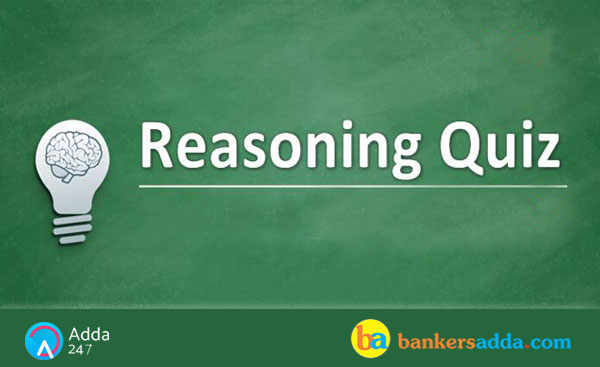Dear Aspirants,

Reasoning Questions for IBPS RRB 2018
Reasoning Ability is an onerous section. With the increasing complexity of questions, it becomes hard for one to give it the cold shoulder. The only way to make the grade in this particular section in the forthcoming banking exams like IBPS RRB is to practice continuously with all your heart and soul. And, to let you practice with the best of the latest pattern questions, here is the Adda247 Reasoning Quiz based on the study plan and the exact same pattern of questions that are being asked in the exams.
Direction (1-5): Study the following information carefully and answer the given questions.
Ten persons are sitting in two parallel rows containing 5 persons in each row in such a way that there is an equal distance between adjacent persons. In the 1st row P, Q, R, S and T are sitting and all of them are facing south. In the 2nd row J, K, L, M and N are sitting and all of them are facing north but not necessarily in the same order. There are two vacant places, one in each row.
The one who is an immediate neighbour of S is facing M. Q does not sit at the extreme ends of the row and faces vacant place of another row. L and N are immediate neighbours. There are only two places between T and R. N sits third to the left of M. J sits at the immediate left of N. K sits at extreme end of the row. R faces immediate neighbour of J. S sits at extreme left end of the row. One of the immediate neighbors of T faces one of the vacant place. P does not sit to the left of R.
Q1. Who among the following sits between R and T?
(a) S
(b) Q
(c) P
(d) J
(e) None of these
Q2. Who among the following faces R?
(a) K
(b) L
(c) S
(d) N
(e) None of these
Q3. Who among the following sits second to the right of the person who faces K?
(a) Q
(b) T
(c) M
(d) L
(e) None of these
Q4. How many persons sit between P and S?
(a) One
(b) Two
(c) Three
(d) Can’t be determined
(e) None of these
Q5. Four of the following five are alike in a certain way based on the given seating arrangement and hence form a group. Which is the one that does not belong to that group?
(a) R, N
(b) Q, L
(c) M, T
(d) K, S
(e) J, P
Directions (6-10): Study the following information carefully to answer the given questions:
Eight friends J, K, L, M, N, O, P and Q are seated in a straight line facing north, but not necessarily in the same order.
N sits third to the left of O who sits at one of the extreme ends of the row.Neither N nor O is an immediate neighbor of L.Q and L are immediate neighbors. Neither Q nor L sits extreme end of the row. K sits third to the right of L.M does not sit at any extreme end of the row.Neither M nor Q is neighbour of N. J is third to the left of M.
Q6. What is the position of J with respect to K?
(a) Immediate left
(b) Immediate right
(c) Second to the left
(d) Second to the right
(e) None of these.
Q7. How many persons sit between L and O?
(a) One
(b) Three
(c) Five
(d) None
(e) None of these
Q8. Based on the given arrangement, which of the following is true with respect to N?
(a) Only two persons sit between N and M.
(b) Only two persons sit to the right of N.
(c) None of the given options is true.
(d) Both J and K are immediate neighbors of N.
(e) J sits on the immediate right of N.
Q9. Who among the following represents the person seated at the extreme end of the line?
(a) M
(b) P
(c) K
(d) L
(e) Q
Q10. Who sits between L and J?
(a) N
(b) K
(c) No one
(d) M
(e) None of these.
Directions (11-15): Study the following information to answer the given questions:
Twelve people are sitting in two parallel rows containing six in each. In row-1 P, Q, R, S, T and V are seated and all of them are facing South. In row-2 A, B, C, D, E and F are seated and all of them are facing North. Each member seated in a row faces another member of the other row. Some of these persons are married who have kids.
S sits third to right of Q. Either S or Q sits at an extreme end of the row and one of them is married. The one who faces Q sits second to right of E. The one who is sitting 2nd to the left of T has four kids. The one who is sitting to the immediate left of P has the same number of kids as the number of persons sitting to the left of the person who is sitting opposite to V. Two people sit between B and F. The number of kids R have is the same as the sum of the number of kids of the immediate neighbours of S. The person sitting to the immediate right of B has no daughters. The person sitting to the immediate left of B has no sons. Neither B nor F sits at an extreme end of the row. The immediate neighbour of B faces the person who sits third to left of P. Number of daughters of E is equal to the number of sons of D. A has the same number of kids as Q. The sum of the number of kids of E and D is equal to the number of kids of A. R and T are immediate neighbours of each other. F has no son and only one daughter whereas the person who is sitting at one of the ends has only one son and has one child.C sits second to the left of A. Total number of daughters of F and E is equal to the total number of kids of B. C has equal number of daughters and sons. T does not face the immediate neighbour of D but she has only one kid. The number of kids of both the persons who are sitting at the ends of one of the rows (either row1 or row2) is equal.
Q11. Who amongst the following sit at extreme ends of the rows?
(a) S, D
(b) Q, A
(c) V, C
(d) P, D
(e) Q, F
Q12. What is the sum of the total number of kids of the persons sitting in row 2 ?
(a) Thirteen
(b) Twelve
(c) Fourteen
(d) Fifteen
(e) None of these
Q13. P is related to A in the same way as S is related to B based on the given arrangement. To which of the following is T related to, following the same pattern?
(a) C
(b) D
(c) E
(d) F
(e) Cannot be determined
Q14. Which of the following is true regarding T ?
(a) F faces T
(b) V is an immediate neighbour of T
(c) F faces the one who is second to right of T
(d) T sits at one of the extreme ends of the line
(e) Q sits second to the right of T
Q15. What is the total number of sons of the persons sitting on row 1?
(a) 9
(b) 1
(c) 8
(d) Can’t be determined
(e) 7




 GA Questions Asked in PNB LBO Exam 2025-...
GA Questions Asked in PNB LBO Exam 2025-...
 OICL AO Admit Card 2025-26 Out at orient...
OICL AO Admit Card 2025-26 Out at orient...
 SEBI Grade A Admit Card 2025-26 Out @seb...
SEBI Grade A Admit Card 2025-26 Out @seb...








